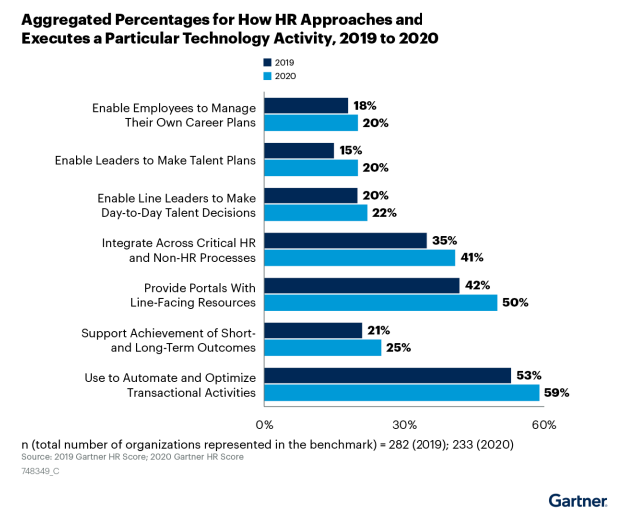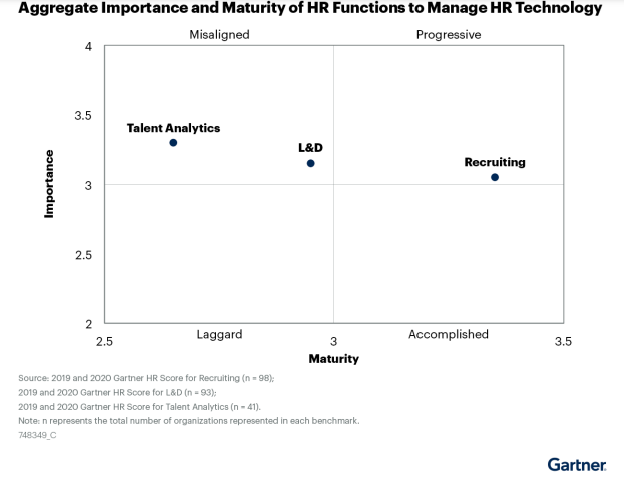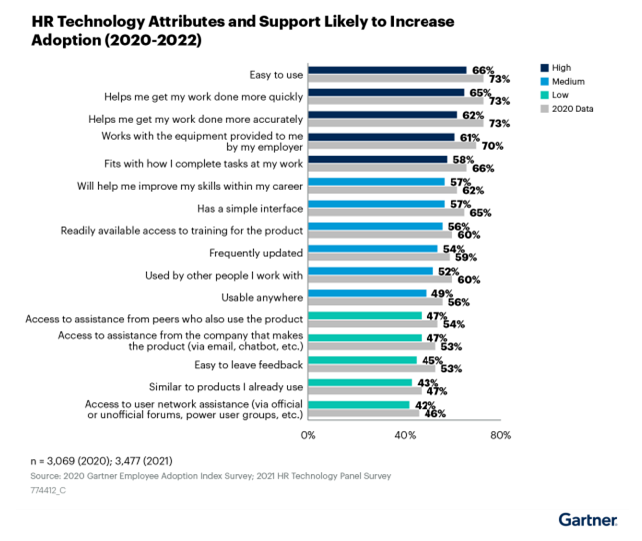
What are your people looking for in HR tech?
Aligning your HR tech investments with your business’s strategic goals – and your peoples’ expectations
Despite decreasing budgets, recent analysis by Gartner found that HR leaders plan to maintain their technology spend.It’s an understandable decision. Talent shortages and the reality of hybrid working put even greater emphasis on people. While everyone can agree that HR technology is important, HR functions have made slow progress in adopting it. Most HR functions use technology for automation, optimizing transactional activities, and curating resources for employees. But only 20% of core HR technology is aligned to enable leaders to make talent plans – and only one quarter supports achievement of short- and long-term talent outcomes.
This is creating some unique misalignments between HR practices and HR technology adoption and overall organizational strategy – resulting in limited adoption of more targeted HR systems aligned to business objectives.
With all this in mind, we’d like to talk a little about your strategy for HR and HCM tech adoption. Including which attributes of tech have the biggest impact on adoption, and how to leverage technology effectively to achieve the outcomes your people are looking for.
How are HR leaders adopting and implementing technology?

This chart shows that the majority of HR functions use technology for automation, optimization of transactional activities, and curating resources for their people.
But only 20% of HR tech has been procured with an eye to helping leaders make coherent long term talent plans. And only a quarter supports the achievement of short-and long-term talent outcomes.
There is a clear gap between ambition and reality when it comes to HR (and HR technology’s) ability to significantly impact strategic business outcomes.
Taking the next step in HR maturity will require leveraging tech for more complex data rich processes – and that will require a big change not just to the technology HR leaders select, but to how they plan, procure, and govern the use of that technology.
We think that nothing illustrates this more than the chart below.

Recruiting shows the highest level of maturity in HR tech adoption, with Learning and Development lagging far behind, and Talent Analytics trailing in third place. This makes perfect sense to us, because it’s a rough reflection of the complexity, non-linearity, and data-dependency of each of these core HR functions.
This situation also reflects basic necessities – virtually all companies have been forced to turn to technology to manage the bulk of their recruiting since the advent of lockdowns. 89% of organizations now use virtual interviewing, and 75% have made the move to virtual onboarding.
Learning and development has also been forced to shift to virtual channels (which is just as well, because people are 58% more likely to apply skills learned virtually.)
Talent analytics, however, lags behind because many organizations simply didn’t see it as a necessity prior to the pandemic, and have not been inspired to adopt it. Few business leaders or employees have a clear idea of how talent analytics can actually help them. And this means HR leaders have a challenge ahead of them in explaining its value proposition to their organizations.
Key attributes of HR tech that enhance (or inhibit) adoption
Technology is only useful to your organization insofar as people use it. With that in mind, here are Gartner’s highlights for which attributes of a particular tool are likely to increase its adoption.

Here’s the ones we find most interesting:
Ease of use: This one stands out as a no-brainer. The most powerful talent management system in the world will not help you find, engage, or retain people if nobody can figure out how to use it.
Also important here is the factor of integration with equipment provided by the employer. This is especially important as remote and hybrid work became more prevalent. How HR platforms and tools are integrated into the wider “digital experience” of your people is only likely to increase in importance – as is its compatibility with their own personal approach to managing their workflows. Great tech must integrate seamlessly into the everyday flow of work – rather than become a monolith that forces everyone to work around it. Unit4’s solutions make it possible for your people to interact with HR software via the apps they’re already using – such as booking and approving absences via Microsoft applications – and without having to navigate to a separate system (such as via voice commands to our virtual assistant, Wanda.)
To this end, you should also be concentrating your investment in tech and tools that help get work done more quickly and accurately and which fit with how your people complete tasks at work. Barriers in technology integration can be disruptive enough in a fully office-based environment, but in a remote environment they can be truly ruinous.
In practical terms, this will mean focusing on tools that reduce the administrative burdens (in terms of time spent) of interacting with the HR department and the HR department’s technology. Customization capacities, user experience, and intelligent automation will all be key features for you to consider.
One of the most interesting considerations listed in the “medium impact” range is the idea of tech that helps people with improving their skills. In an era where “lifelong employment” is an increasingly distant memory, people are becoming much more self-driven in managing their development and taking control of their career destiny. To this end, they’re looking for tools (and the employers that use them!) which will help them to skill up to the next level.
This fact is reflected in the importance of qualities like access to training and skills advancement. It’s also interesting to note that while training is usually HR’s go-to for educating people about the company and its systems and processes – and their required job skills – this is both unlikely to ensure either adoption of new tech or to improve skills.
To this end, you’ll need to focus your attentions on tools that can help your people to improve both skills and productivity – and on advertising that the platforms you’ve adopted have these capabilities.
“We believe that tech should enable organizational leaders to help guide and develop their teams. It isn’t for tech to end or replace face to face interaction but to act as a tool to enable leaders to focus on more meaningful engagements with their employees and understanding the needs of the individuals to help shape their development. Tech can facilitate a company’s move to developing a culture of continuous feedback and learning. At Unit4 we are already using tech to achieve our aim of simplifying and automating our HR practices and processes allowing time to be spent on building our learning culture and developing our people..” – Tania Garret, Chief People Officer, Unit4
How can Unit4 help you?
Unit4’s HCM suite is designed not only to provide a unified HR platform that syncs your people data with financial data for an integrated view of the workforce (and a better people experience). Our solutions give you the power to attract and recruit the best talent, the analytics to understand how your peoples’ skillsets can be best deployed across your organization, and the learning and development tools you need to ensure your entire workforce is growing and engaged with the work they’re doing. Helping them adopt and use it to further their own goals, and thus further the goals of your whole organization.
To get an idea of what Unit4 HCM can do for you, check out its dedicated product page here or click here to book a demo.





